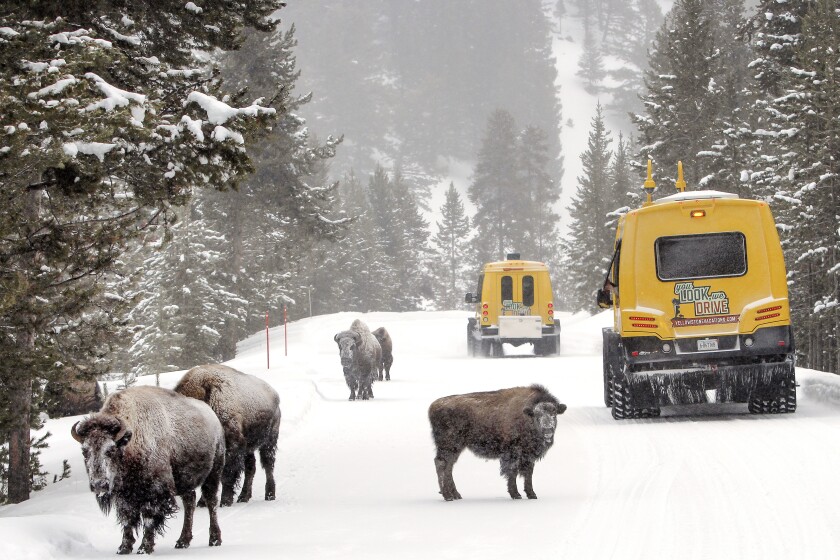ALONG THE FIREHOLE RIVER - The big bull bison, off on his own from the herd, was thrashing his head to clear a spot in the deep snow, trying to dig his way down to something edible along the shoreline.
A flock of mallards on the river were dabbling for food as swans just downstream strained their necks underwater to find vegetation. A red fox was perched on a fallen tree that stretched out over the river.
ADVERTISEMENT
The open water of the Firehole, warmed by a constant flow from nearby hot springs, poured down a valley on the way to merging with the Gibbon River where the two become the Madison, one of the most storied trout streams in the nation.
“This is one of my favorite spots in the park,’’ said Zach Hoy, a certified snow tour guide in winter and a trout fishing guide in summer, as we watched the wildlife.
Hoy was our driver, historian and naturalist on an eight-hour snowcoach tour of Yellowstone National Park. The world’s first national park offers a dazzling display of white and warmth in winter - snow, hot springs, geysers and mud-pots - sprinkled with wildlife and with very few other tourists in the way.
The snowcoach is climate-controlled, all-terrain and an easy way to see the park in winter - suitable for senior citizens or people with disabilities as well as young children and anyone else who doesn’t know how or feel like operating a snow machine on their own. The only other way to get into most of the park is on a snowmobile tour with a certified guide from a licensed operator.
“Most of my trips are on snowmobile, so this is kind of nice for a change. I didn’t need so many layers,’’ Hoy said as he drove the giant converted van fitted with tank-track like devices where each wheel would go.
The park, since 2003, has been for the most part closed to general unrestricted snowmobiling after problems with air emissions and noise from older sleds, incursions into wilderness areas and general overcrowding at popular spots.
The snowcoaches and guided snowmobile tours were offered as an alternative to keep winter visitors on trails and under control, while eliminating problems with emissions caused by older two-cycle snow machines.
ADVERTISEMENT
If speed is your thrill, don’t come here: Snowcoaches are limited to 25 mph in the park, snowmobiles to 35 mph.
There are 2.2 million acres of mostly wild country in the park, some 3,500-square miles of mountains, rivers, lakes and thermal basins - a veritable geological wonderland that inspires awe no matter how often one returns. And wildlife. Lots of wildlife. Bison, elk, moose, fox, wolves, otters, bobcat, coyotes, eagles, swans, ducks, geese, ravens and more are out and about in winter. The grizzly bears are mostly sleeping.
It’s not uncommon for bison to congregate and travel on the park’s highways that in winter are converted to groomed snowmobile trails closed to cars and trucks. The unplowed but packed roads make for much easier walking for the hulking animals compared to trudging through 3 feet of snow in the woods.
Bison have the official right-of way and can sometimes linger on the trails. But they usually, eventually, get out of the way to allow snowmobiles and snowcoaches to pass. The 1,000-pound animals - more than 2,000 pounds for a big bull - can be intimidating to snowmobilers as the animals pass just a few feet away. Less so when you are inside a big snowcoach.
“It’s the calves that are the rowdiest around people. They are the ones that can get the herd riled up sometimes,’’ said Hoy, a Midwesterner who moved to West Yellowstone 13 years ago and stayed.
Other animals can be easily seen against the white backdrop of snow-covered meadows, geyser basins and forests. Our crew spotted coyotes sleeping and eagles perched hundreds of yards off against the backdrop of white.
Most of Yellowstone’s backcountry is true wilderness, accessible only on foot or ski. But winter on Yellowstone's groomed trails is not necessarily a wilderness experience. There can be small crowds of snowmobiles and snow coaches in popular spots like Old Faithful and the Grand Canyon of the Yellowstone River. But, compared to summer, winter in the park is almost devoid of people thanks to restrictions on winter visitors compared to unlimited summer visitation.
ADVERTISEMENT
Since 2013 snowmobile and snowcoach trips have been limited each day for commercial tours (a few roads at the north end of the park are open to allow access to the community of Cook City, Mont., and are not limited.) All told, only 33,000 people entered the park in January this year. That compares to more than 30,000 people on a busy summer day, with nearly 1 million people entering the park in July alone.
“Last year was the third-busiest on record for the park, with 2016 at the top and 2017 second. The park is being loved to death in summer when vehicle congestion and accidents, campground crowding and lack of lodging are ongoing issues. Since 2008, annual visitation to Yellowstone has increased by more than 40 percent, the Park Service notes, causing “overflowing parking lots, a rise in traffic jams, roadside soil erosion and vegetation trampling and unsanitary conditions around busy bathrooms.”
“But in winter, the visitation is more stable. And it’s spread out. It really is a great time to visit,’’ Veress said.










